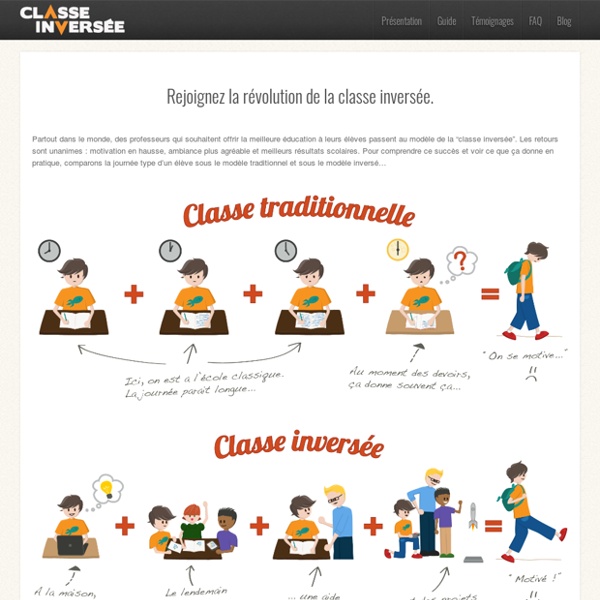



http://www.classeinversee.com/
Related: Flipped classroom infos • Classe inversée • Clase invertidaSocial Development Theory (Vygotsky) Summary: Social Development Theory argues that social interaction precedes development; consciousness and cognition are the end product of socialization and social behavior. Originator: Lev Vygotsky (1896-1934). Key terms: Zone of Proximal Development (ZPD), More Knowledgeable Other (MKO) Vygotsky’s Social Development Theory Vygotsky’s Social Development Theory is the work of Russian psychologist Lev Vygotsky (1896-1934), who lived during Russian Revolution.
10 Teacher-Tested Tools for Flipping Your Classroom - Getting Smart by Susan Lucille Davis - blended learning, digital learning, education technology, flipclass, flipped class, flipped classroom, Online Learning, Teaching, the flipped classroom For the past couple of weeks, I’ve spent some time addressing my earlier commitments to flipping at least some portion of my Language Arts classes. (You can learn about my ongoing saga at “4 Ways Flipping Forces Fundamental Change” and at “Why I Haven’t Flipped…Yet”). Reading FlipYour Classroom by Jonathan Bergmann and Aaron Sams provided practical advice and a justification for flipping, Learning about the Stanford studies that suggest better results from flipping your flipping (that is, doing hands-on work in the classroom first, reinforced by flipped lessons at night) But, ultimately, what I needed to do was to dive in and try out some tools with my kids and my curriculum in mind. The unexpected result: I’ve had to acknowledge something I hadn’t really thought about — I am a video-phobe.
Flipped-Learning Toolkit Thinking about flipping your classroom? Flipped-learning pioneers Jon Bergmann and Aaron Sams walk you through the steps you need to take to make blended learning a reality. Read More About Flipped Learning Video lectures at home? Homework in class?
Toward a common definition of "flipped learning" - Casting Out Nines We’ve seen a significant ramping up of interest in – and exposure to – the flipped/inverted classroom over the last few years, and it’s been nice to see an uptick in the amount of research being done into its effectiveness. But one thing that’s been lacking has been a consensus on what the flipped classroom actually is. If a professor assigns readings to do before class and then holds discussions in class, is that “the flipped classroom”? I’ve said in the past that it is not (necessarily), but that’s just me. Now, however, a group of educators and others interested in flipped learning are proposing a common definition of flipped learning, and it’s pretty interesting.
Flipped Classroom How flipping works for you Save time; stop repeating yourself Record re-usable video lessons, so you don't have to do it again next year. It's easy to make minor updates to perfect lessons over time once the initial recording is done. Let students take control of their learning Not all students learn at the same pace. Flipped Classroom 2.0: Competency Learning With Videos The flipped classroom model generated a lot of excitement initially, but more recently some educators — even those who were initial advocates — have expressed disillusionment with the idea of assigning students to watch instructional videos at home and work on problem solving and practice in class. Biggest criticisms: watching videos of lectures wasn’t all that revolutionary, that it perpetuated bad teaching and raised questions about equal access to digital technology. Now flipped classroom may have reached equilibrium, neither loved nor hated, just another potential tool for teachers — if done well. “You never want to get stuck in a rut and keep doing the same thing over and over,” said Aaron Sams, a former high school chemistry teacher turned consultant who helped pioneer flipped classroom learning in an edWeb webinar. “The flipped classroom is not about the video,” said Jonathan Bergmann, Sams’ fellow teacher who helped fine tune and improve a flipped classroom strategy.
10 Free Resources for Flipping Your Classroom Thanks to the folks over at Khan Academy, alternative modes of delivering classroom instruction are all the rage. We’ve got face to face models, labs, rotations, online-only, self-blend, and of course, flipped. While there are numerous ways to implement a flipped classroom, the basic components include some form of prerecorded lectures that are then followed by in-class work.
Pros and cons of teaching a flipped classroom The concept of “flipped classrooms” has been a hot topic for the past couple of years. Can instruction be effectively delivered at home, freeing up class time for debates, projects and labs? The model flips the traditional approach of using class time for explaining concepts and homework for reinforcement. In the beginning, many teachers dove all in, but soon faced challenges. Then it started to lose favor. Anecdotally – we’re hearing it’s making a comeback. Using TeacherTube in the Flipped Classroom - TeacherTube Official Blog TeacherTube Official Blog Social media and online resources have become essential tools for the 21st century classroom. By engaging students through contemporary classroom resources, we not only provide them with career-readiness skills, but also with the opportunity for their voice(s) to be an invaluable part of the learning process. During last week’s #edchat, teachers and educators discussed the important role of student voice in the classroom, and how implementing educational technology can help. One of the main topics of last week’s #edchat was the Flipped Classroom model and how to (successfully) use it in the classroom. As defined in Knewton’s infographic “The Flipped Classroom: Turning Traditional Education on it’s Head,” the basic principle of this model is that it “inverts traditional methods, delivering instruction online outside of the class and moving ‘homework’ into the classroom.” Among the hour, many teachers voiced concerns over the availability of video resources (i.e.